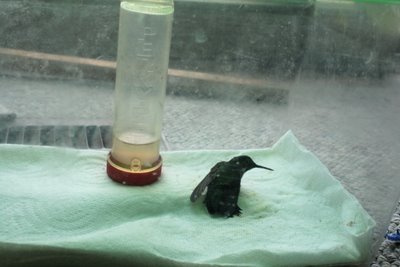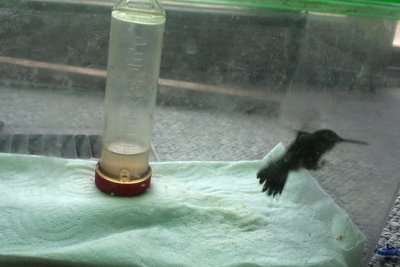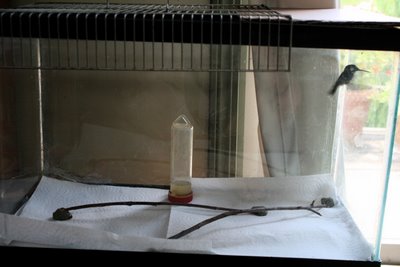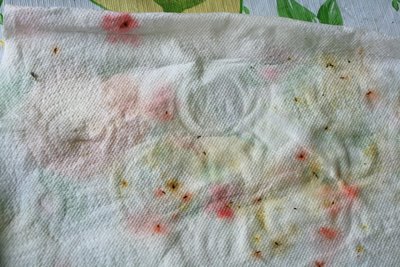Don't buy this. Don't pay $6.49 for something that you could make much better yourself for about a dime. This is not hummingbird food. It's sugar water, tarted up to look pretty with Red Dye #40. And it's really, really bad for hummingbirds. Read on.
 She came to me as they all do, over the phone, with a worried, uncertain voice describing her predicament. She’d blundered into a chemical plant and was found, disabled, around 11 at night. Who knows how long she’d been there, circling the ceiling, bumping her tiny head until she fell senseless at someone’s feet? Repeated efforts to get her to drink nectar had failed, and she was fading fast. I met the caller in town, he on his lunch break, and he opened a makeshift containment system that consisted of two Chinet bowls, lined with tissues and taped together. She was lying on her side, curled in a C, as I would be were I a hummingbird who had been without food for 18 hours. I took the syringe of bright red nectar and inserted her bill into it, as he had repeatedly tried. I held her until she began to struggle, and in struggling her bill opened slightly. Some nectar flowed in and her tongue at last began to flicker, then lash, and red nectar poured out of the corners of her mouth as she took sustenance for the first time. Poor little thing. I smiled at the man. “The key is to piss them off enough so they cuss at you, and their bill opens, and then they get what you’re trying to do.”
She came to me as they all do, over the phone, with a worried, uncertain voice describing her predicament. She’d blundered into a chemical plant and was found, disabled, around 11 at night. Who knows how long she’d been there, circling the ceiling, bumping her tiny head until she fell senseless at someone’s feet? Repeated efforts to get her to drink nectar had failed, and she was fading fast. I met the caller in town, he on his lunch break, and he opened a makeshift containment system that consisted of two Chinet bowls, lined with tissues and taped together. She was lying on her side, curled in a C, as I would be were I a hummingbird who had been without food for 18 hours. I took the syringe of bright red nectar and inserted her bill into it, as he had repeatedly tried. I held her until she began to struggle, and in struggling her bill opened slightly. Some nectar flowed in and her tongue at last began to flicker, then lash, and red nectar poured out of the corners of her mouth as she took sustenance for the first time. Poor little thing. I smiled at the man. “The key is to piss them off enough so they cuss at you, and their bill opens, and then they get what you’re trying to do.”
He told me that she’d been able to fly when they first found her, as high as 12 feet in the air, but only in a tight spiral. That’s OK, as long as she can fly and get altitude, I thought. As long as her wings work, she has a chance at being a hummingbird again, instead of a sad little scrap of feathers like she is now.
 I took her home and made a place for her in a ten-gallon tank, lined with paper towels and fitted with low perches and a feeder.
I took her home and made a place for her in a ten-gallon tank, lined with paper towels and fitted with low perches and a feeder.

I filled it with Nektar-Plus, a hummingbird maintenance diet that includes proteins and vital nutrients—a far cry from the dyed commercial “hummingbird food” she’d been offered. I don’t fault people for buying it; the labeling makes it seem so much better than simple table sugar and water, but it’s not. It’s horrid. If you didn’t have doubts about feeding commercial preparations, check this out. She’d last had commercial nectar around 2 pm on Tuesday. At 2 pm on Wednesday, her droppings still were dyed vivid red.

Red dye
that is used to color commercial “hummingbird food” (generally Red Dye #40) is
derived from coal tar or petrochemicals. It has proven carcinogenic and
mutagenic (meaning that it induces tumors) in rats and mice. Further, it
decreases reproduction rates and increases the incidence of both internal and
skin tumors in these animals. It is banned in Denmark, Belgium, France,
Germany, Austria, Sweden, and Norway, but is still in use in the U.S.
Because
it has not been directly tested on hummingbirds, manufacturers of artificial
nectars containing red dye are on solid ground when they claim that no proof
exists that it is harmful to hummingbirds. That’s true. But neither is there
any research that indicates that red dye is not
harmful to hummingbirds. They also state that the dyes used are FDA approved
for human consumption. That’s true, but the FDA has also set limits for
consumption, and recommends that people not ingest large quantities of a single
dye product. However, when we set up a hummingbird feeder with dyed nectar,
this is just what we’re encouraging hummingbirds to do. And that’s the core of
the problem.
How much
red dye does a hummingbird consume when it visits a feeder containing
artificially colored nectar? A
banded and color-marked rufous hummingbird observed by hummingbird researcher
David Patton took an average of 10 grams of nectar from the same feeder each
day. A popular dry nectar mix contains .21 mg. of dye per gram of dry mix.
Combined with water as directed, a gram of the solution contains .04 mg of Red
#40. A hummingbird taking 10 grams of the mix ingests about .42 mg. of red dye
per day. This works out to .12 mg/g of body weight. It doesn’t sound like much,
until you note that the World Health Organization recommends a daily limit of
only .007 mg/g of body weight in humans. And DNA damage in mice showed up at
concentrations as low as .01 mg/g of body weight.
The
stunning truth is that a hummingbird taking artificially dyed nectar may be
ingesting the dye in concentrations that are 17 times the accepted daily intake
recommended for humans, and 12 times higher than the concentration found to
induce DNA damage in mice. And they may be ingesting it every single day, all
summer long. Yikes. Suddenly, the
anecdotal reports from hummingbird rehabilitators of bill and liver tumors in
hummingbirds known to feed on dyed nectar are cast into an alarming light. It’s
true that no solid research yet exists to prove that red dye is harmful to
hummingbirds. Hummingbirds are not humans; are not
mice. But all hummingbird feeders have red parts that serve to attract the
birds, and artificial nectars have little if any added nutritional value over
sugar water. We’re only pleasing ourselves with the dyed nectar. After all I’d
read, I wondered why anyone who loves hummingbirds would feed them something
that might be harmful to them, in concentrations that are 17 times what’s
thought to be safe for humans.
If you'd like to know what happened to this little hummingbird, just hit Hummingbird Hospital Part II. And from there, you can hit Newer Post and get the rest of the story. We all love the rest of the story.
Thanks for letting me bend your ear about this. Now, on the tiny chance you've gone out and bought that ruby-red stuff, go dump it down the sink and mix up one part table sugar to four parts water. Boil it, let it cool, fill your feeders with something about 1/10 the cost that won't harm these precious little mites.







20 comments:
Oh, man, that's just scary that the stuff that's being used as dye for hummer food may come from mountaintop mining. Diabolical.
Yes, there are a lot of things in this world that just ain't right, and that's one of them. Nice connection, Catbird.
Sheesh! Those red droppings are scary. Thanks for the lesson in hummer food. Not that I would get any hummers. ;-)
Enjoy the rum.
Oh, I meant to say--yay--for Science Chimp-rehabbing an injured & exhausted hummer.
Wow--you are away from home and still dispensing wisdom. I mean, it's not like you can't do both.
I was one of those suckered in by the commercial stuff. Thankfully, I never attracted enough little birds to keep at it.
So, the stuff got dumped.
Now I am glad.
You want sympathy for difficulties posting from Trinidad?
How about 2k dial up from Rondeau.
I’ll trade you.
We had hummingbirds for the first time this spring; they went crazy for the blossoms on our lilac and quince. Nice to know we don't need the coal industry to help us out.
Ah, she's lovely and I'm hoping she is out hovering again soon. Thanks for this post- I've known enough to mix my own nectar but now I think I'll try some of this Nektar Plus. Really- thank you!
I recently set up a hummingbird feeder and filled it with the red stuff. Thanks for posting this, I'll change it to homemade nectar tonight. Fortunately, the feeder is too recent to have been discovered by any hummers.
Julie, thanks for this very vivid, graphic representation of a hummer on a red-dye nectar diet. I've heard and read from various sources that the "jury is still out" on whether the red dye in commercial nectars is bad for the birds, but I think this proves the point. Surely the nectar manufacturers know about this, but they still sell it anyway. How horrible. Our hummers get only sugar H2O, of course, and I cringe everytime I see nectar sold someplace. I'd like to empty out all those displays and just replace them with a little baggy full of 1/4 cup sugar with a note that says "Just add 1 cup hot/boiling water, stir until dissolved, let cool, and serve something NATURAL to your hummers". And good point about the dyes in kids "foods", too.
I hope this rehab has a happy ending!
Thanks for the graphic description and photos of the red poop. This will really help with getting the truth out. And what great fortitude you have and good spelling, considering. I remember the rum punch at Asa Wright very fondly. Tough work, and you seem to get it.
Ugh. I can't tell you the number of people I've argued with over that powdered mixture garbage because they just SWEAR that the hummers have to have the red stuff to be attracted. Hard to explain, then, why I have so many hummingbirds using the ole water/sugar combo.
That stuff really should be taken off the shelves.
I have a couple "old school" hummer feeders I'm sending a link of your post to Julie... maybe that'll convince them of what I've been telling them all along.
I'm dumping my red humming bird feed tonight.
"Coal tar dyes" were once derived from coal tar, but many now come from petroleum. Still not good, though, and used in lipsticks, hair colorings, and numerous other products.
Only 7 percent of US coal production comes from MTR, so the odds of it being the source of red dye are small.
DG
i just love that people from so many walks of life take the time to catch and care about a little bird.
If one reader throws the commercial dyed stuff out, I've done my job.
Deleriously happy from Trinidad,
JZ
More than 1, Julie... I took the liberty of posting a link to your site and this blog entry on Dave's Garden and two people over there said last night they were dumping their red-dye goo stuff.
Every little bit counts... that's how change happens, one person at a time.
Haven't used the red stuff since the free bag that came with my first Perky Pet feeder. Ever since I learned the right way, I make my own sugar solution. (That's 4 parts water to 1 part table sugar, for anyone who might have forgotten.) Change it every 203 days, and don't use honey or artificial sweetners. The former ferments to quickly and may contain bacterial contaminants, the latter has no nutritional value for hummers.
Great post, Julie, and those red droppings are really frightening!
Love this -
~Kathi
er - just re-read my last comment. That's 2-3 (2 OR 3) days, not 203 days. (Think how gross THAT feeder would be!)
~Kathi, the typo-queen
Some boil the sugar H2O, others just stir & dispense into feeders. I’ve done both. Does it really matter?
Post a Comment